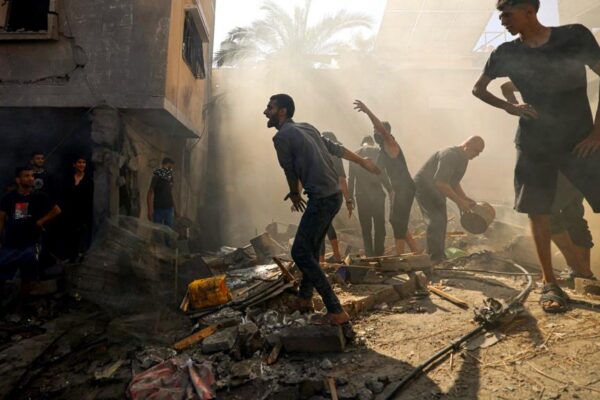Collective consciousness about who is to blame is key. Collective consciousness about who is truly suffering is key.
Victimhood and (Lack of) Blame: An Analysis of Israeli Narratives and Their Effects on Our Psychology and Behaviour
Collective consciousness about who is to blame is key. Collective consciousness about who is truly suffering is key.
“If you’re not careful, the newspapers will have you hating the people who are being oppressed, and loving the people who are doing the oppressing.” Malcolm X/El-Hajj Malik El-Shabazz
Over the past couple of weeks, the world watched as Israel intensified its oppression of Palestinians following the resistance of the Sheikh Jarrah residents to forced expulsion from their homes. Over 278 people were killed across the Palestinian territories (248 in Gaza) and over 1900 were injured in Gaza (1).
The UN reported that at least 58,000 Palestinians in Gaza are now homeless and have sought refuge in UN Relief and Works Agency shelter schools (2). Residential buildings, press offices, and health and medical buildings were bombed and destroyed by Israel (2, 3). Twelve Israeli settlers were killed by rocket fire from Gaza City (1).
On Friday, March 21 2021 at 2:00am, a ceasefire was announced. On Friday morning, Palestinians in Al-Aqsa Mosque in Al-Quds/Jerusalem were attacked with tear gas by Israeli forces (4).
As these events unfolded, Palestinians in Palestine continuously shared what was happening on the ground through videos, pictures, and social media lives. They urged everyone around the world to help amplify their voices and share their story on social media platforms and among their family, friends, and colleagues. There was a global response to this call for solidarity and we saw what some have described as the start of the erosion of the mainstream media and Israeli narratives about what is happening in Palestine/Israel (5).
After the ceasefire was announced, Mohammed El-Kurd, an author and poet from Sheikh Jarrah whose family is under threat of displacement and has been at the forefront of sharing the events on the ground through social media, tweeted:
“The ceasefire is likely to the Israeli occupation authorities losing – severely, remarkably, and unprecedentedly – losing the [public relations] battle. But the battle hasn’t ended yet: we’re working to implement a dramatic shift in public opinion which takes time and rigor.”
He also said “Remember: you control the news cycle, your content, your rage, what you force the world to talk about.”
In these tweets, Mohammed is making a powerful argument, that is: part of the Palestinian victory was won on the battleground of narratives.
The Battle Over Narrative
Battles over narrative are nothing new. Throughout history, opposing groups have fought not only over land, treasures, and other material resources, but also over who can tell the story and how to tell it. In other words, battles have not happened solely using military and physical strength, but through words, images, and sound.
We may be tempted to underestimate this type of battle because it appears less intense, less violent, less consequential than physical and military battles. However, that is far from the truth. While it is true that words themselves do not directly kill, they can no doubt pave the way for something as horrific as genocide. Oppression often persists in cases where the version of events that reaches the public is the sanitized version of the oppressors who have more hard and soft power than the people they are oppressing.
The question then arises: why is the battle over narrative important? First, foremost, and most importantly, any lover and seeker of truth should understand that the truth must always be privileged, no matter with whom it stands (Holy Quran, 4:135), and any attempt to distort or cover it up should be condemned and resisted vehemently. However, next to this, why battle over narrative? What is the strategic advantage of winning this battle?
There are several reasons for this, but what I want to highlight is this: when one is able to shape the narrative, they can shape hearts and minds. They can influence what we believe about what is happening, who shoulders the blame and should be held accountable, and who the victim is, and who should be supported and backed. This, in turn, has consequences for what we believe are the right positions to hold towards the situation and what are the rightful actions that we, our communities, and our governments should take.
In other words, the dominant narratives can influence what the public (particularly those less familiar with the issue) believe and feel about the issue and the various sides involved, and this shapes what they believe are the right ways to respond, if at all.
Knowing this, you can imagine what a dangerous tool narrative can be when it is dominated by oppressors and those committing injustices. The introductory quote by Malcolm X is a prime example of the consequences of narratives being told by the oppressors.
Let’s break down some of the common Israeli and mainstream media narratives and the implications they may have on our beliefs, feelings, and behaviours.
Narratives And Their Implications
The Israeli narrative has many different facets to it, but it generally goes something like this: Palestinians attack Israel and threaten the lives of its population. Israel has no choice but to defend itself against the Palestinians who seek to destroy it. Therefore, it bombs Gaza, and the children and women killed and the schools, hospitals, and homes destroyed are collateral damage. If only armed resistance groups didn’t operate from these areas!
Central to the Israeli narrative is their claim over the status of victimhood and the distancing of themselves from blame or responsibility. They allege that everything they do is based on the principle of self-defense and any Palestinian deaths are a result of the actions of the Palestinians themselves.
This narrative does several things. To start, it associates Israel with morality and Palestinians with amorality and violence, and it does so in two ways. First, it absolves Israel of being the instigator and assigns that (amoral) status instead to the Palestinians. Most people can agree that the one who aggresses first is the one in the wrong and is the oppressor (regardless of the reaction of the group being oppressed).
Second, this narrative associates Israel with morality and Palestinians with amorality through the claim that Israel is acting out of “self-defense” and Palestinians are deliberately trying to hurt or kill. Similar to above, most people agree that victims of aggression have the right to defend themselves and that those who intentionally seek to hurt innocent others are committing an immoral act.
Together these narratives promote the belief that Israel is the moral, oppressed group and encourage the public to feel sympathy towards them. The narratives may even contribute to producing feelings of respect or admiration for what some may believe is Israel’s “bravery” in “defending itself” against attacks.
In the case of the Palestinians, it would not come as a surprise that these narratives will have the opposite effect. Not only do they dissuade the public from feeling any sympathy for the Palestinians by positioning them as the instigators and responsible for their own suffering (6), but they promote feelings of anger, disgust, or contempt towards them.
What social movement and collective action psychology research tells us is that emotions of anger, indignation, or contempt are important motivators for action (7). When we experience strong feelings of indignation towards someone, we feel motivated to act against them in order to rectify the wrong we believe they have committed.
In contrast, sympathy is often associated with a desire to help or support the person or group we feel sorry for. When Israel positions itself as a victim who is reacting out of self-defense, they are essentially telling us to feel sympathetic for them and to support them against their aggressors who are intentionally harming them.
In contrast, when they position the Palestinians as the violent aggressors, they are trying to direct negative feelings like anger or hate towards them, thus facilitating either 1) action against the Palestinians by the public/governments (e.g., blocking aid to refugees or impoverished areas), 2) apathy or inaction in response to Palestinian suffering and calls for support (e.g., not signing petitions, attending protests, or not making statements of solidarity), and/or 3) support for Israel’s continued aggression against the Palestinians.
Narrative Two and Three: Conflict And The Missing Perpetrator
Another narrative we typically see in the mainstream media is that the relationship between Israel and Palestinians is one of “conflict” between equal sides, rather than one of an occupier and an occupied indigenous people. We also see the media report on the death and destruction of Gaza without naming who is responsible for it. These types of discourses are harmful.
The first narrative effectively erases the fact that Israel is much more militarily, politically, and economically advantaged than the Palestinians and suggests that the two are on equal grounds in these and other aspects. In this way, it ignores the multi-dimensional power dynamic between the two, thereby distilling the oppression and marginalisation of the Palestinians. In other words, it robs the Palestinians of being recognised as they are, victims (8) of occupation, displacement, ethnic cleansing, and intergenerational and direct trauma.
The second type of discourse is not only unproductive for achieving justice but can be detrimental to it. This is because it neglects to mention who is actually committing the crimes against Palestinians. When we see a group of people being harmed but are not told who is harming them, whose feet do we hold to the fire? How can we call for justice when we do not know who to hold accountable?
While this discourse may produce sympathy or sadness for the Palestinian victims, it hinders the production of indignation towards those oppressing these victims, an emotion that, remember, has great mobilizing potential. This quelling of indignation towards the perpetrator, just like its production towards their opponents as we saw above, is strategic precisely because it plays a part in reducing the potential for mobilization against the perpetrator.
In other words, deterring the masses from feeling indignant towards Israel by not naming them as the violators of Palestinian human rights serves to pacify the people and prevent them from holding Israel accountable for their aggression.
You can imagine how the discourse of “conflict” might also contribute to a sense of apathy among the public. If you were watching a fight between two equally capable opponents, you might not feel the need to step in and aid either party because this is a fight between equals.
Now imagine if you saw that one opponent had a weapon and the other is fighting with their hands and without anything to protect themselves. You might feel sorry for this disadvantaged person and angry at the advantaged person for continuing to hit despite their unfair advantage. You might then feel moved to support the disadvantaged person. This dynamic can be applied in social justice contexts.
The more weak or helpless we feel someone is, the more moved we are to help them because we sympathise with them or pity them (9). Thus, framing Palestinians and Israelis as equal in military and physical strength helps to create the perception that they are more advantaged than they actually are and clouds the public’s ability to see them as they are: the more marginalised and disadvantaged on the military, physical, and political fronts (10).
Interdependent Narratives And An Overarching Goal Of Israeli Propaganda
It’s important to emphasize that these narratives (and the others not discussed in this article) do not operate in a vacuum independent of each other or other supporting discourses (such as orientalist and religious discourses). These narratives build off each other and create a larger “grand narrative” that promotes support/sympathy for Israel and apathy towards or a denigration of the Palestinian cause.
But perhaps most importantly, the result of these narratives, each one independently as well as considered collectively, is that the perpetrator and occupier are left without accountability.
When Israel is framed as reacting in self-defense when the relationship between Israel and Palestine is framed as a conflict between two equal parties instead of one of occupier and occupied, and when Israel’s crimes are not attributed to Israel but are discussed as if they happened without a perpetrator, then how can the public ever come to consciousness about the reality of Israeli occupation and hold Israel accountable?
Collective consciousness about who is to blame is key. Collective consciousness about who is truly suffering is key. And it is not only that the victims and perpetrators need to be named truthfully, but how we talk about the reality of each should reflect the truth of the matter. Anything other than the truth hurts. It hurts individuals. It hurts families. It hurts communities and nations.
Confront untruthful and misleading narratives by continuing to talk about Palestine, and do it in a way that is educated and represents the reality of the situation. Mohammed Al-Kurd reminded us that changing public opinion is not easy nor quick, but it’s already started and we must keep the momentum going. Mohammed said it best: “…Talk about Palestine. Talk about Gaza. Sheikh Jarrah. Don’t tire! Don’t bore!”
References
- https://www.aljazeera.com/news/2021/5/24/root-causes-of-israel-palestine-conflict-must-be-addressed-unrwa
- https://www.businessinsider.com/un-says-58000-palestinians-displaced-in-gaza-by-israels-bombing-2021-5
- https://www.theguardian.com/world/2021/may/17/israeli-strikes-gaza-health-system-doctors-hospitals
- https://www.aljazeera.com/news/2021/5/21/jubilation-in-gaza-as-ceasefire-takes-effect-palestine-israel-live
- https://www.vox.com/22436208/palestinians-gaza-israel-tiktok-social-media
- Dunn, J. L. (2004). The politics of empathy: Social movements and victim repertoires. Sociological Focus, 37(3), 235–250. https://doi.org/10.1080/00380237.2004.10571244
- Jasper, J. M. (2018). The Emotions of protest. Chicago, United States of America: University of Chicago Press.
- The term victim is sometimes associated with a person/group that is helpless, weak, and in need of being saved by another, and indeed, some victims do fit this definition. However, when I refer to Palestinians as “victims”, my intention is not to label them as weak, helpless, or powerless but instead to point out that injustice is being committed against them and that they are on the receiving end of oppression and aggression. Palestinians have and continue to struggle in every way possible to achieve justice and self-determination, and those who support them follow their lead.
- Jasper, J. M., Young, M. P., & Zuern, E. (2020). Public Characters: The Politics of Reputation and Blame. Oxford University Press.
- To be clear, military and physical strength are only a couple of ways to measure the more holistic idea of strength. Strength also includes having truth on your side, hope for justice in your heart, and determination in just actions.





